This is a Veteran Owned site
![]()
 |
Evaluating these two excellent machines took much longer than I anticipated but I now have a shop full of very sharp tools! Click image to enlarge |
JET & Tormek Wet Sharpeners
Side-By-Side in the Real World
Text & photos by Tom Hintz
Posted – 10-13-2006
NOTE: Portions of this comparison were inspired by a supposedly confidential report, based on testing of the JET Wet Sharpener done by TORMEK and released publicly by a major US-based Tormek importer/distributor on an open forum. Within 48 hours of that posting, 22 copies of the report (PDF) were sent to NewWoodworker.com LLC in emails from viewers. Titled, “Comparison between the TORMEK 2006 machine and an imitator”, the report appears to compare the JET Wet Sharpener to the TORMEK SuperGrind but there is no direct reference to the JET Wet Sharpener anywhere in the report. The TORMEK brand is understandably prominent but the machine it is compared to is described only as the “Imitator”. For our purposes here, this document will be referred to as “The Imitator Report.”
Comparison Procedures
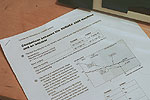 |
The "Imitator Report" done by Tormek, has caught the eye of a bunch of skeptical folks, many of whom have been sending copies to me! Stop it! Click image to enlarge |
Laboratory testing is valid only if conducted by a qualified, independent facility, using real-world parameters they establish based on the habits of the average end user. Since I have no laboratory (not even one of those cool long, white coats…) the comparisons in this article are based solely on in-shop use of both machines with no extraordinary forces applied to either machine. I think it is most legitimate to see how each machine handles a basic range of sharpening tasks common to a reasonably active and diverse woodworking shop.
I should also note that I have been using the TORMEK SuperGrind with very good results for several years. Because the sharpening techniques used on both machines are very similar, I do not think my experience with the TORMEK SuperGrind skews the results one way or the other.
Physical Size
The JET Wet Sharpener and TORMEK SuperGrind both weighed in at 29 lbs dry. The JET Wet Sharpener has a somewhat larger cabinet and an overall physical footprint of 19”-long by 11”-deep and 12 ¾”-tall. The TORMEK SuperGrind measures 15”-long by 10”-deep and 12 ¾”-tall. (Measurements were taken to the outmost projection on each side. Height was measured to the top of the grinding wheel, the highest point on both machines.)
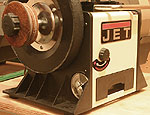 |
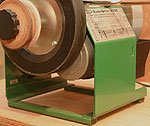 |
Both cabinets are well made and solid. The JET Wet Sharpener (top left) is a little bigger than the Tormek SuperGrind (top right) overall and uses part of that extra space for a storage drawer. (bottom right) Click images to enlarge |
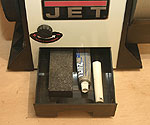 |
Both machines sit on four rubber feet with those on the JET Wet Sharpener spaced 11 ½-wide and 9 ¼”-deep. The feet on the TORMEK SuperGrind are placed 9”-wide and 9”-deep. (The feet were measured to the outside edges.)
The support bars that locate and guide the tool jigs are identical in shape and diameter. When mounted in the horizontal, dual clamping mounts on both machines, the top of the bar is 9 3/8” above the table surface on the JET Wet Sharpener and 9 ¾” on the TORMEK SuperGrind.
The primary difference between the support arms is that the JET Wet Sharpener version uses a standard thread with ground flats where the locking knobs make contact. The TORMEK SuperGrind has an Apex thread that is flat on the top surface all the way around. When moving the JET Wet Sharpener version from left to right (grinding to honing) the locking knobs may have to be backed out a little more to get the arm into the mount. The TORMEK SuperGrind Apex threads should eliminate having to loosen the locking knobs.
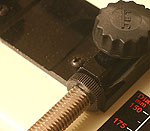 |
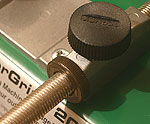 |
Both machines have fine adjustments built into the support arms. The JET (left) grinds a flat on the threads for the locking knob to seat on while the Tormek (right) uses a flat-topped Apex thread that makes it a bit easier to switch the arm without backing the locking knobs out a little extra. Click images to enlarge |
|
Both machines have double locking mounts in both the horizontal and vertical positions. Locking both legs of the support arms makes them very rigid. Throughout the evaluation, movement or deflection of the support arm was not an issue on either machine.
Cabinets
Both the JET Wet Sharpener and TORMEK SuperGrind are built around formed steel cabinets. The steel used to fabricate both cabinets is more than strong enough for the application.
The JET Wet Sharpener cabinet is a bit larger and has panels enclosing the ends to help keep the interior clean. JET makes use of the larger, protected interior by adding a 5 ¾”-wide by 7 ½”-long and 1 ¾”-deep storage drawer.
The TORMEK SuperGrind leaves both sides open and has no in-cabinet storage. In the years I have used the TORMEK SuperGrind, significant contamination of the cabinet interior has not been a problem.
 |
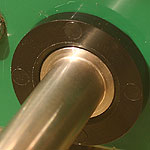 |
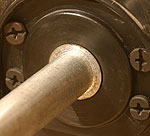 |
Tormek provided a new stainless steel driveshaft to update my machine. (top) The top driveshaft is the plated steel version, like the one used in the Jet, that came out of my Tormek and shows virtually no corrosion. (middle) Tormek uses a plastic bearing in each side of the cabinet. I replaced them also and they did not show excessive wear. The Jet uses (bottom) powdered metal bushings that are covered by a plastic shield to help prevent contamination. Click images to enlarge |
The TORMEK SuperGrind has a stainless steel drive shaft, (also stainless washers and nuts) that runs in plastic bearings set into either side of the housing. The JET Wet Sharpener used a plated steel drive shaft and hardware running in powdered metal bushings, also in either side of the housing. The JET bushings have a plastic shield that helps protect them from debris.
Prior to doing this evaluation TORMEK supplied the parts necessary to update my TORMEK SuperGrind to match how they are currently shipped. That included a stainless steel drive shaft to replace the plated one used when my TORMEK SuperGrind was manufactured. You can see in the photos that the plated drive shaft (top) came out of the TORMEK in very good condition even though it has been in use for several years.
A stainless steel shaft will obviously resist corrosion better than the plated version but so far, I have found no indication that corrosion is starting on the JET Wet Sharpener shaft. The longevity of the plated drive shaft removed from the TORMEK bodes well for the lifespan of the similar one in the JET Wet Sharpener.
Stability
The Imitator Report suggests that the placement of the rubber feet on the grinding wheel side of the JET Wet Sharpener could cause it to tip when heavy pressure is applied to the grinding wheel. Taken to the extreme, that might be a possibility. However, the amount of force needed to approach tipping exceeds that required for even heavy sharpening by a wide margin. After over 100 hours of using the JET Wet Sharpener I can say that stability is not an issue.
Because TORMEK does not offer a base similar to the two-drawer unit that is frequently included in the current JET Wet Sharpener basic package, it was removed from the JET Wet Sharpener for all testing during this evaluation.
Water Management
The JET Wet Sharpener has an extended outboard lip on the water tank that catches drips from wide tools when they hang off the side of the grinding stone. This lip also makes filling the tank easier with the odd containers I (and you I hope) find myself using to carry water around the shop.
 |
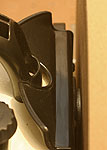 |
JET extended the outboard lip of the water tank (top left) and added a splashguard (top right) next to the handle to divert more water back to the tank. Click images to enlarge |
|
The tank also has two sets of mounts, one higher than the other. The upper set of tank mounts is for when the grinding wheel is worn to a smaller diameter. Installing the tank in the higher mounts increases the level of water surrounding the wheel and improves saturation.
A splashguard between the carry handle and the edge of the cabinet divert drips coming from that side of the grinding wheel, sending them back to the tank rather than under the machine.
Instructions
While the JET Wet Sharpener and TORMEK SuperGrind come with very good instructions, their presentation differs. The JET Wet Sharpener includes a DVD that shows how to set up and use the machine itself and provides equally complete setup and use information on the jigs available from JET to use with it. JET also packs a printed pamphlet containing exploded diagrams and parts lists for the JET Wet Sharpener and the JET line of jigs.
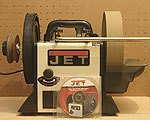 |
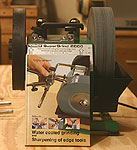 |
JET includes a nicely done DVD (left) that covers setup and use of the machine itself, plus the same information on all of the jigs they have available. Tormek (right) provides a very well done, hard-cover manual that contains the same type of information. Click images to enlarge |
|
The TORMEK SuperGrind includes a high quality, heavily illustrated (549 line drawings) printed manual that also describes the setup and use of the machine. Individual chapters cover setup and use of the TORMEK line of jigs.
TORMEK also provides a VHS videotape with instructions on the machine and jigs. I have not seen this videotape personally but my experience with TORMEK suggests it is well done. The only downside is it being a VHS videotape, a fast disappearing medium. One demerit for TORMEK on that count.
Both instruction modes are very well done and provide users with good information. In this area, the JET Wet Sharpener enjoys a small edge because of the popular DVD format.
Note: I have been informed that TORMEK began shipping the machine with a DVD so cancel the demerit and call this point a draw.
Wheels
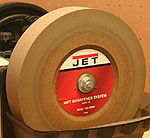 |
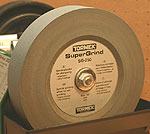 |
The JET (left) and Tormek (right) grinding wheels are identical in size but differ in composition. Both cut well and resist wear. The JET wheel seems to require less pressure to maintain a cut than the Tormek in many cases. Click images to enlarge |
|
The grinding wheels on the JET Wet Sharpener and TORMEK SuperGrind are advertised at 10”-diameter and 2”-wide. Both are slightly under the 10” dimension when prepared for use. The TORMEK SuperGrind usually requires the surface to be cut prior to use while the JET Wet Sharpener comes from the factory with the grinding wheel already faced.
Both the JET Wet Sharpener and TORMEK SuperGrind grinding wheels are rated at 220-grit when treated with the coarse side of the stone graders. The fine side of the JET stone grader approximates an 800 to 1400-grit surface while the fine side of the TORMEK stone grader approximates an 1000-grit surface.
NOTE: The stone graders used with the JET Wet Sharpener and TORMEK SuperGrind alter the surface texture of the grinding wheels to approximate the grit ratings. Neither stone grader actually changes the grit of the grinding wheel.
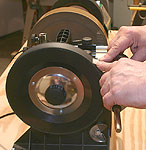 |
 |
Both the Jet and Tormek use (left) leather-covered honing wheels. However, the Tormek honing wheel is a little smaller, enough to just fit inside the JET honing wheel. Both work very well.
Click images to enlarge |
|
The drive wheels on the JET Wet Sharpener and TORMEK SuperGrind both have a rubber friction ring bonded to a plastic hub that is secured to the drive shaft that in turn drives the stone grinding wheel. The drive wheel on the JET Wet Sharpener is 7 ¼”-diameter while the TORMEK SuperGrind uses a 6 ½”-diameter drive wheel. Both machines have a 9 mm-diameter (0.354”) motor spindle that turns against the drive wheels giving the JET Wet Sharpener a 20.480 to 1 drive ratio and the TORMEK SuperGrind an 18.361 to 1.
These substantial drive ratios are responsible for the low rpm of the grinding stone. They also provide a serious mechanical advantage that allows relatively small motors to supply more than ample power to maintain relatively consistent grinding wheel rpm despite the frictional drag of grinding.
The leather covered honing wheels are also very similar on both machines but also differ in diameter. The JET Wet Sharpener honing wheel is 9 1/8”-diameter while the TORMEK SuperGrind is 8 7/16”-diameter. Both have a 1¼”-wide leather surface.
The larger diameter of the JET Wet Sharpener honing wheel gives it a small SFPM (surface feet per minute) advantage over the TORMEK SuperGrind version at the base 90 rpm. However, the JET Wet Sharpener Variable Speed feature means that can be increased to 150 rpm, giving it the advantage in pure honing speed.
Motors
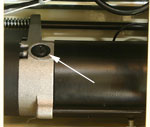 |
The JET DC motor has replaceable brushes, a feature that will be of interest mainly to industrial type users. The Tormek induction motor has no brushes. Click image to enlarge |
One of the bigger differences between these two machines is in the style of motor used. The JET Wet Sharpener comes with a 120V, 1.8A, 3550 rpm DC motor (DC motor necessary for variable speed) while the TORMEK SuperGrind uses a 110V, 1.8A, 1680 rpm induction motor. Both rpm ratings are under no-load conditions.
The JET Wet Sharpener motor has user-replaceable brushes while the TORMEK SuperGrind maintenance-free motor does not. Replaceable brushes are more likely to benefit industrial users where run time is many times that seen in a hobbyist shop. Average woodworkers may never have to change the brushes but it is handy to have available.
The Imitator Report suggests that the JET Wet Sharpener DC motor runs hotter than the TORMEK SuperGrind induction version. DC motors are designed and built to operate efficiently in a higher temperature range so this is not an unexpected nor damaging trait of the JET Wet Sharpener motor.
Despite racking up nearly 100 hours of run time while preparing my earlier Tool Review of the JET Wet Sharpener and this comparison, the JET Wet Sharpener motor never reached even mildly high temperatures. Over the final three days of testing I often let the JET Wet Sharpener run while comparative operations were being performed on the TORMEK SuperGrind. Through it all, the JET Wet Sharpener motor never became too hot to touch, a hands-on test I did frequently through the drawer opening.
Controls
 |
 |
 |
While both machines have water-resistant On/Off switches as on the Tormek (top left) JET added the Torque Control (top right) and Variable Speed Controls (left) Click images to enlarge |
Both the JET Wet Sharpener and TORMEK SuperGrind have water-resistant On/Off switches. Both are located on the “back” of the machines and both work fine.
JET added two more, a Torque Adjuster and a Variable Speed Control. TORMEK says their machine does not require these controls and that is born out in our testing. However, the same can be said about the JET Wet Sharpener as it never seemed to “need” these controls either.
The JET Torque Adjuster is a simple mechanism that increases the friction between the drive spindle and the drive wheel. Both the JET Wet Sharpener and TORMEK SuperGrind use the weight of the motor (both hung from a pivot mount) to generate friction between the bare metal spindle and the rubber drive wheel. This is a common configuration for friction drives.
The JET Wet Sharpener drive worked fine throughout the evaluation and did not require the assistance of the Torque Adjuster. However, after years of use, the rubber drive ring could glaze and slip if it becomes wet. At that point the JET Torque Adjuster will be a much-appreciated feature as giving it a quick turn allows you to continue working. Cleaning or conditioning (light sanding) of the drive ring will still be necessary but you can finish the task at hand first.
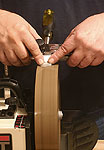 |
JET's Variable Speed Control comes in handy when tackling tough jobs like changing the bevel angle on a bench chisel. Increasing the speed makes this job go faster without having to bear down on the grinding wheel. Click image to enlarge |
For me, the most impressive “new thinking” on the JET Wet Sharpener is the Variable Speed Control. Intended to compensate for normal grinding wheel diameter loss (wear) to maintain the optimum SFPM rate, the rpm markings around the Variable Speed Control dial each have the grinding wheel diameter that the setting corresponds to.
In addition, being able to increase the SFPM of the grinding and honing wheels for demanding jobs is very useful. Increasing the SFPM makes grinding and honing operations more aggressive without having to increase pressure on the tool being sharpened to unreasonable levels. The longer I used the JET Wet Sharpener, the more I used the Variable Speed Control.
TORMEK says their wheel maintains its efficiency without increasing speed and I saw nothing during the evaluation to refute that. The JET Wet Sharpener also retained its grinding efficiency with the Variable Speed Control set at the 90-rpm base rate.
During the original Tool Review testing of the JET Wet Sharpener and the evaluations for this comparison I found that using the Variable Speed Control to increase rpm/SFPM made both grinding and honing operations a bit more aggressive on the JET Wet Sharpener. In each case, increasing rpm/SFPM allowed finishing a sharpening or honing task faster without having to apply excessive pressure on the tool. Not having to bear down on the tool being sharpened is not only easier but also a good thing for the life of the grinding wheel.
Honing wheel speed on both machines is a compromise because it is driven equally to the grinding stone. The JET Wet Sharpener speed control enables the user to increase the rpm of the honing wheel to polish an edge more quickly. Virtually the same refined finish can be obtained on the TORMEK SuperGrind honing wheel with a little more time invested. I timed polishing the bevel on a 1”-wide bench chisel on both machines and found them to be virtually equal with the JET Wet Sharpener set at 90 rpm. However, increasing the JET Wet Sharpener to 125 rpm reduced honing time by about 20%, averaged over three attempts.
Jigs & Setups
Both the JET Wet Sharpener and TORMEK SuperGrind have a large number of jigs available, all of which are compatible with either machine. While TORMEK’s history gives them the edge in the number of jigs, particularly for specialty applications, don’t be surprised to see new jigs from both camps in the near future. While similar jigs from each manufacturer will be used for each task, the jigs themselves will not be compared in this article. I will say that there were no set up or use problems encountered with any of the jigs used.
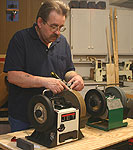 |
Between doing the original Tool Review of the JET Wet Sharpener and this comparison, I logged over 100 hours of use on it. I have been using the Tormek SuperGrind for several years and found both machines are very effective. Click image to enlarge |
Because changing angles will be part of the comparison, one angle finding device was used to set up both machines to eliminate any differences in their accuracy (I know of none) and the more likely errors on my part. I flipped a coin and the TORMEK SuperGrind won.
In the Shop
Throughout the evaluation, no problems were encountered with either machine. Both grinding stones were surfaced and allowed to run in fresh water until the tank level stabilized to be sure that they were properly saturated before each test. All of the tools used were ground to a known base angle prior to beginning testing to be sure the same amount of material would be removed by each machine.
The grinding wheel on the TORMEK SuperGrind was worn to just over 9” in diameter while the JET Wet Sharpener wheel measured 9 ¾”-diameter at the beginning of this evaluation. TORMEK states that their grinding wheel maintains its efficiency without increasing rpm.
Though both machines are capable of sharpening a huge range of tools, our evaluation focused on a 1 ½”-wide plane iron, 1”-wide bench chisel, a 1”-wide roughing (wood turning lathe) gouge and a ½” fingernail bowl gouge. Each test was completed three times on each machine and the results averaged to minimize irregularities on my part while performing them.
Grinding Efficiency
 |
 |
Testing of each tool was repeated three times on each machine and the results from each machine averaged. Click images to enlarge |
|
For all of the grinding tests, the JET Wet Sharpener was set at 90 rpm to match the TORMEK SuperGrind and both wheels graded to the same fine or coarse states. Following that base comparison, the tests were repeated (also three times) with the JET Wet Sharpener set to 125 rpm and those results noted.
First, a 1 ½”-wide plane iron was reduced 2-degrees with both machines using the straight edge jig supplied in both basic kits. The TORMEK SuperGrind took 4:20-minutes and the JET Wet Sharpener (90-rpm) took 4:30-minutes. At 125 rpm the JET Wet Sharpener took 3:15-minutes to make the same change.
Next, the angle of a 1”-wide bench chisel was changed from 25 to 23-degrees, again using the included straight edge jig. That change took 4:30-minutes on both the JET Wet Sharpener and the TORMEK SuperGrind. With the JET Wet Sharpener set at 125 rpm, that same change took 3:30 minutes.
Changing a 1”-roughing gouge (carving tool jigs used on both machines) by 2-degrees took 5:20-minutes on the TORMEK SuperGrind and 5:00-minutes on the JET Wet Sharpener at 90-rpm. Increasing the JET Wet Sharpener to 125 rpm reduced that time to 4:15-minutes.
Finally, a ½”-wide, fingernail bowl gouge was changed by 2-degrees using the gouge jig from each manufacturer. The TORMEK SuperGrind took 7:30-minutes, with the JET Wet Sharpener taking the same amount of time at 90-rpm. Setting the JET Wet Sharpener to 125 rpm reduced that time to 5:45-minutes.
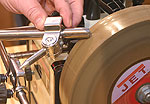 |
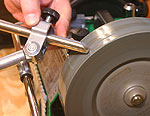 |
Despite sharpening a diverse group of shop tools, including the complicated fingernail-style bowl gouge both the JET Wet Sharpener and Tormek SuperGrind handled them all exceptionally well.
Click images to enlarge |
|
Following each of these tests, the grinding wheels were graded to their fine states and the scratch patterns reduced. Rather than bore you with all those numbers, suffice it to say that the same pattern of times for each machine continued. Changing to the honing wheels also produced the same, small time spread. Most notable was that when the JET Wet Sharpener was increased to 150 rpm, honing time was on average cut in half. In all cases, the edges produced by the JET Wet Sharpener and TORMEK SuperGrind were extremely sharp and impossible to distinguish from each other visually.
The result of more than 30 hours of grinding on the JET Wet Sharpener and TORMEK SuperGrind (each test repeated three times) is that there is little difference in grinding or honing performance between them in normal use when the JET Wet Sharpener is set at the base 90 rpm. Overall the JET Wet Sharpener has a small honing advantage at the base 90 rpm setting.
However, dialing the JET Wet Sharpener up to 125 rpm consistently reduced grinding and honing times even though no additional pressure was applied. The increased rpm made the grinding and honing actions a bit more aggressive but easy to control.
Grinding stone wear after 30 hours of testing was negligible on both machines. Neither stone wheel suffered damage requiring a truing cut.
Stone Graders
One difference noted is with the stone graders. The TORMEK SuperGrind stone is both a little finer and harder than the JET Wet Sharpener version. The TORMEK stone grader also required more pressure to be applied to condition the grinding stone than did the one from JET.
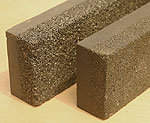 |
 |
The stone graders for the JET and Tormek look alike (left) but are different. The JET version is a bit more coarse, seems to work with less pressure and the coarse side resists loading up (sealing) better than the Tormek. (Note: I used a new Tormek stone grader for this review.)
Click image to enlarge |
|
The Imitator Report claims the JET Wet Sharpener stone grader wears 20-times faster than the TORMEK SuperGrind version. While I did not find the same disparity in wear in my testing, I believe it could be approximated if the same level of pressure is applied to the JET stone grader as is necessary when using the TORMEK stone grader. The JET Wet Sharpener stone grader works more easily at considerably less pressure and, when used that way, wear is only slightly greater than that seen on the TORMEK version.
I also noticed that the coarse side of the TORMEK stone grader appeared to seal up (smooth over) more quickly than the one from JET. There is a noticeable difference in the coarse sides of both stone graders with the TORMEK being finer which may contribute to the smoothing of its surface. While I could still grade the TORMEK grinding stone, it took a little longer than on the JET. The difference was under a minute in most cases so it’s not a huge deal.
Grading the grinding wheel from coarse to fine required about 30-seconds on the TORMEK SuperGrind and roughly the same amount of time on the JET Wet Sharpener though the resulting JET wheel surface seemed (and acted) finer in terms of the scratch pattern left on the tool.
Base Packages
Note: The contents of the base packages described below are typical of those being offered at this writing. (10-10-2006) Be sure to check the current package contents when ordering as they may vary with the vendor!
 |
While both basic packages are very similar, JET has been including this storage base. Because this base is wider and Tormek does not offer a similar item, I removed this base for all of the testing procedures. I put it back on as soon as that evaluation was completed because those two drawers come in very handy. Click image to enlarge |
JET Wet Sharpener basic package: The JET Wet Sharpener machine, stone grinding wheel, leather-covered honing wheel, tube of honing compound, straight edge jig, support arm, instructional DVD, parts diagram pamphlet, stone grader, angle measuring device, angle setting device and tool storage tray/base.
TORMEK SuperGrind basic package: The TORMEK SuperGrind machine, stone grinding wheel, leather-covered honing wheel, tube of honing compound, straight edge jig, support arm (vertical and horizontal mounts), angle setting gauge (with angle-checking notches), instruction manual, instructional VHS video tape.
Conclusions
From the start of this evaluation it was obvious that these are both excellent machines, each capable of producing super-sharp edges on virtually any cutting tool in our shops. In fact, lay similar tools side-by-side, one sharpened on the JET Wet Sharpener and another sharpened on the TORMEK SuperGrind and the cutting edges are indistinguishable from each other.
Both the JET Wet Sharpener and TORMEK SuperGrind are very well built. Each handled moderate to heavy and often extended periods of sharpening without a whimper, overheating or other signs of stress. Neither grinding stone wheel showed appreciable wear from the base truing done before starting this evaluation. In fact, both stones were flat, true and ready for use at the end of the evaluation. Grade them to the state needed and both are ready to go.
Video Tour! |
The warrantees covering these machines clearly demonstrate the confidence their manufacturers have in them. The JET Wet Sharpener is covered by a 5-year warranty and the TORMEK SuperGrind carries a 6-year warranty. Both are much longer than is typical of warrantees in the woodworking world today.
Neither machine is difficult to use once the operator becomes familiar with the basic procedures. In most cases, the instructional materials provided with both machines will get a new operator up to speed quickly.
The grinding action feels like it differs between the JET Wet Sharpener and TORMEK SuperGrind in that the JET seems to remove metal faster with less pressure. Bearing down on the TORMEK appears to equal that rate of metal removal but I have always felt that excessive pressure on the tool being sharpened is at least partially responsible for the grinding wheel going out of round. Applying that level of pressure is also tiring, particularly for those of us with hands that live at the end of our rapidly aging 50-something arms. Completing the same sharpening tasks was easier on the JET Wet Sharpener because it cut well with less pressure.
Overall, the new features of the JET Wet Sharpener pushed it over the top in this evaluation. The water management features, Torque Adjuster and Variable Speed Control and grinding wheel properties make the JET Wet Sharpener faster, made it easier to use and more versatile.
The extended outboard lip of the JET Wet Sharpener water tank does catch more errant water but really does not come into play until sharpening very wide tools. However, it does make filling the tank without making a mess a little easier.
Check the Pricing |
|
The inboard splashguard is very effective at directing water back into the tank rather than under the machine. This splashguard helps when sharpening even normal width plane irons and wide bench chisels.
The Torque Adjuster is a good idea and it is effective. However, it is not a day-to-day device but rather one that will allow you to complete the sharpening task at hand before stopping to clean or condition the drive wheel. Despite well over 100 hours of relatively hard use, the JET Wet Sharpener drive has yet to slip, so the Torque Adjuster has not been used beyond giving it a turn to see how it worked.
The Variable Speed Control on the JET Wet Sharpener is the standout new feature and one I found myself using frequently. In addition to the evaluations for this comparison (rpm kept equal to the TORMEK SuperGrind) I was sharpening several of my turning tools and found the ability to speed the grinding wheel shortened those tasks noticeably. At the honing wheel, the increased rpm was even more of a benefit. Producing the mirror-finished bevels I like on turning tools was faster than I am accustomed to.
 |
These bench chisels were sharpened and honed on the Jet Wet Sharpener (left) and the Tormek SuperGrind (right). Lay them side-by-side and you can see there is no difference. Both are extremely sharp with a fine polish to the bevel. Click image to enlarge |
Finally, there is price. While I understand the importance of price to all of us on a budget, this is one case where value is unquestioned. Both machines in this comparison are excellent in terms of construction and performance. As stated, I believe the JET Wet Sharpener has the advantage overall but there is absolutely nothing wrong with the TORMEK SuperGrind.
At this writing, (10-10-2006) the TORMEK SuperGrind basic package is selling for $399.99 while the basic JET Wet Sharpener package costs $299.99. See the links in this section for current pricing and package contents details.
The ability to sharpen our own tools is not only a time-saver; it can save money as well. Not having to send a tool out for sharpening is certainly convenient and over the long run, could be cheaper as well.
For me, an equally important factor is that I can more easily experiment to develop my own edge angles that cut the way I like best. Plus, having my own machine means I can sharpen my tools right and on my own schedule.
See the Jet Wet Sharpener Review
See the Tormek SuperGrind Review
Have a comment on this comparison? - Email Me!
All written, photographic and drawn materials are property of and copyright by NewWoodworker.com LLC 2000-2019. Materials may not be used in any way without the written permission of the owner.


